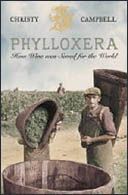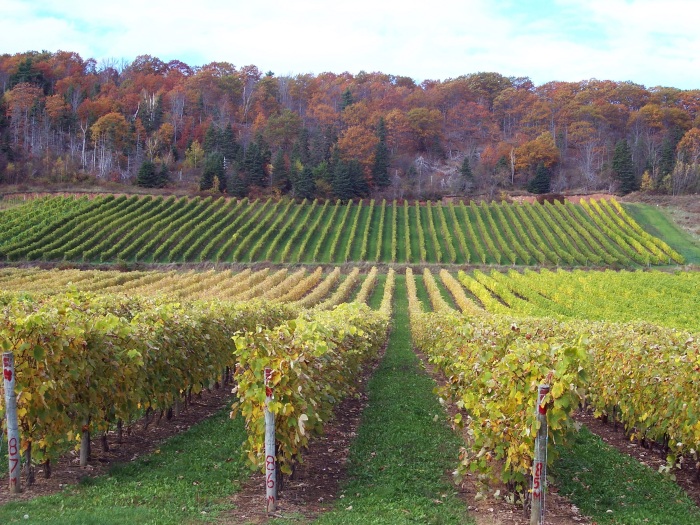Posts Tagged ‘book review; wine industry; invasive pests; climate change; politics; skeptics’
Phylloxera, wine, and some climate parallels
I picked up a used book at one of my favourite bookstores, Pulp Fiction. It’s titled Phylloxera, which is the name of a bug that almost destroyed the wine industry in the nineteenth century.
 It caught my eye because I’m a nerd, I like learning about insects, agriculture, and, of course, wine. But what surprised me are the obvious parallels with the current climate crisis: the collective denial, the refusal to accept science, the entrenched political positions, it all seems completely contemporary.
It caught my eye because I’m a nerd, I like learning about insects, agriculture, and, of course, wine. But what surprised me are the obvious parallels with the current climate crisis: the collective denial, the refusal to accept science, the entrenched political positions, it all seems completely contemporary.
From a science point of view, the book doesn’t disappoint: the phylloxera aphid has one of the most complicated life cycles I’ve read about (it mostly reproduces asexually, with only females around, and will sprout wings, but only some times). And when introduced to Europe, the bug changed its life cycle, living undergroud to take advantage of the lack of resistance of the roots of European vines, making it undetectable until the plant was dying.
It’s a great detective story. Guardian reviewer Malcolm Gluck compares the wine merchant Borty, whose imported American vines introduced the disease to France, to the villain Moriarty while in the Sherlock Holmes role is the witty and indefatigable Professeur Planchon, who finally solved the enigma; except that instead of foggy London, the story takes place, in the vineyards of sunny southern France and eastern US.
It’s also fascinating to be immersed in an era when science was fresh and new, fighting traditionally accepted views held by conservative nineteenth century French peasant. The emerging disease of the vineyards was variously characterised as a divinely appointed scourge (because of loose morals – sounds familiar?); a disease transmitted through the bad smells of rotting grapes (Pasteur, and the germ theory of disease, was only emerging); or it was caused by modern contraptions, from the noise and smoke of locomotives, or mysterious emanations from telegraphic wires.
The disease spread slowly, from infected vineyards to neighbouring healthy ones, but also jumped, appearing suddenly hundreds of kilometres away. Eventually, thanks to the work of Planchon and others, the spread of the disease was traced to the invasive pest, and the trade in American rootstock that carried it.
It didn’t help that the foremost entomologist of France, a Professeur Signoret, claimed that the presence of the aphid was merely a symptom of poor growing conditions and could not be the actual cause of the disease. The influential scientist clung to this (wrong) theory his whole life, causing enormous delays in the implementation of effective action against the disease. Sounds familiar?
Further, as long as the disease was mostly concentrated in southern France, Paris was completely indifferent to the plight of the southern growers (the Parisian elite drank only the grands crus from Bordeaux or Burgundy). The economic thinkers of the time were of the laissez-faire school, believing in a market solution, willfully blind to the oncoming – and preventable – catastrophe. (This eventually changed as the bug spread to the Grands Chateaux.) Again, this is eerily familiar and contemporary.
As now, there were the entrenched interests: in this case, the chemical groups selling pesticides of dubious effectiveness, and the railway companies transporting the chemicals, both fully opposed to any solution other than chemical dousing.
What was the solution? Here, there is a happy ending: the realization that European vines could be grafted onto resistant American rootstock without changing the character of the wine produced. In France, Italy, Spain, everywhere vintners went on to a massive grafting campaign, and the industry was saved.
But was it really? Can we be sure that, say, a great Nuits-Saint-Georges tastes the same now as it did before the phylloxera? We can’t, and the book concludes on a melancholy note: do we know what is gone? Have we lost an amazing diversity of taste experiences because of all the obfuscations and delays in applying a known effective solution?
I can’t help but think about our current climate predicament. What are we losing by twiddling our collective thumbs, listening to the skeptical Signorets of our day? And while the climate is already affecting the wine industry, one would wish that this crisis affected only a single industry, like wine, important as it might be…
Campbell, Christy 2004. Phylloxera: how wine was saved for the world. London: Harper Perennial

